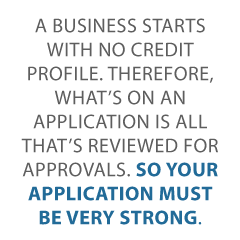It’s a new year. Whether you have a new business or you have been running your business for a while, these tips will help make sure you have a business setup for success in 2022 and beyond.
Why Does Your Business Setup Matter?
The way you set your business up affects its fundability. It cannot be fundable if it is not built on a foundation of fundability. What is fundability, and what are the building blocks of a fundable foundation?
Fundability is a business’s current ability to get funding. Of course, there are things you cannot control related to fundability. Yet, there are plenty of factors you can control. These are what you need to focus on. They include setting your business up with a fundable foundation, and more.
Business Setup: a Fundable Foundation
Follow these steps to build a fundable foundation for your business.
Step 1: Don’t Neglect Your Business Name
This is more important than you may think. It includes a lot more than just choosing a name. First, check with your Secretary of State to find out if they require that a business name be unique.
Then, keep any indication of a high-risk or restricted industry out of your business name. Your business can be Rachel’s rather than Rachel’s Gas Station. This can help prevent an automatic or nearly automatic denial from a lender just because of the type of business. It can increase the chances that your business actually gets a chance at funding.
If your business is perceived as high risk from the beginning, the application may not even get to the underwriting process.
Step 2: Address Your Business Address
A fundable business setup includes a physical address where you can receive mail. Never use an UPS box or a P.O. Box. In fact, some lenders will not approve and fund unless this is the case. If you don’t want to use your home address, you can use a virtual address. In fact, it’s not a bad idea if you need to hold a meeting or an interview. Regus, Davinci, and Alliance Virtual Offices are all good options. Still, keep in mind that there are credit providers that will not accept virtual addresses.
Step 3: Make the Right Call With Your Business Phone Number
Not surprisingly, toll-free phone numbers are best. Lenders see them as a sign of business credibility. It’s very easy and inexpensive to set up a virtual local phone or a toll free number. If you want to avoid a separate phone, just have your business number forwarded to your personal phone.
Additionally, your business number needs to be listed with 411 for most credit issuers and lenders to approve you. Check for your record to see if you’re listed. While you’re at it, make sure your information is accurate. No record? Then use ListYourself.net to get a listing.
Step 4: Jump in With An EIN
Now, get a free EIN for your business at IRS.gov. This is an identifying number for your business. It’s similar to your personal Social Security Number. You’ll use it on all of your business documents.
Step 5: Set Up an Incorporated Business Entity
Incorporating gives you more credibility in many cases. It sets up your business as separate from you, its owner. Of course, by default incorporating reduces your personal liability. Other entities, like sole proprietorships and partnerships, do neither.
Step 6: Get Licensed
Contact State, County, and City Government offices to see if there are any required licenses and permits to operate your type of business. Licensing requirements differ depending on state, town, and industry. Always make sure you have the proper licensing for your corporation. Often, your Secretary of State will have this information.
Step 7: Open a Business Bank Account in the Business’s Name
You must have a separate, dedicated business bank account. Keep in mind, you have to keep business and personal funds separate for the IRS anyway. Having a separate business account makes that process easier and reduces the risk of audit at tax time.
More than that, many credit issuers require a business bank account before they will approve you for an account. In addition, the date you open your business bank account is the day that lenders consider your business to have started.
As a result, it doesn’t matter if you incorporated your business 10 years ago. If you just opened the business bank account yesterday, then in the eyes of credit issuers your business started yesterday. Since there is a minimum time in business requirement on almost all business credit accounts, the sooner you open your business bank account, the better.
A business bank account is also required for getting a merchant account, so your business can accept credit cards. For years, studies have shown that customers spend more with plastic than with cash.
Step 8: Do Not Underestimate the Importance of a Business Web Domain and Professional Website
It’s highly likely that lenders and credit providers will research your business online. As you can imagine, it is best if they learn everything directly from your business website. Not having a company website can hurt your chances of getting business credit. Keep in mind though, an unprofessional website can do just as much damage.
You need it to be a professional website. That means it’s got to have helpful information for anyone who finds your company online. Additionally, it should be hosted professionally. Buy web hosting from a hosting company like GoDaddy or HostGator. Try to avoid a free version of a hosting service like Weebly or Wix.
Your domain should be your business name, if possible. A free Wix or Weebly domain does not look professional. For example, www.yourbusiness.com appears much more professional than www.yourbusiness.wix.com.
Furthermore, you need a company email address for your business. Guess what? It needs to be on the same domain as your website. It often comes with a website domain provider such as GoDaddy. Do not use Yahoo, AOL, Gmail, Hotmail, or other free email services. Again, owner@yourbusiness.com appears much more professional than yourbusiness@yahoo.com.
Beyond the Foundation
After you set your business up with a fundable foundation, the next business setup consideration is risk. For some businesses this isn’t an issue at all when it comes to funding. Yet, for others, it can be tricky.
Step 9: Choose NAICS Codes Wisely
The North American Industry Classification System (NAICS) is the standard used by Federal statistical agencies. You choose your NAICS code on the IRS website.
There are inherent issues in every single industry. However, those listed under certain NAICS codes are considered riskier than others. It doesn’t matter if the business is prospering, they are still considered a risky business. Usually higher risk comes from chances of injury or frequently engaging in cash transactions, or a low barrier to entry.
The IRS, lenders, banks, insurance companies, and business CRAs use NAICS codes. They are trying to determine if your business is in a high-risk industry classification. The NAICS puts out a list of high-risk and high-cash industries. Higher risk industries include casinos, pawn shops, and liquor stores but the NAICS list is old and has not been updated in years.
Why Risk Matters
When it comes to funding, risk matters big time. There are several industries where lending institutions are hesitant to do business. In those particular cases, there are stricter underwriting guidelines. In contrast, some industries are considered so risky they are automatically denied.
Those businesses are left looking for other business funding solutions.
These can include:
Using a Different NAICS Code
Of course you want to be impeccably honest when it comes to selecting your NAICS code. Still, if more than one can apply, you don’t have to choose the one that’s higher risk. It pays to check and be careful when making your selection.
If only high risk codes apply, there’s nothing at all wrong with changing your business to match a related but lower risk code.
Step 10: Be Consistent!
A big reason for many credit and loan denials is inconsistent business information. This makes it hard for the lender to locate a business offline or online. It also sets off fraud alarms in the minds of those making lending decisions.
To avoid this, make certain your business name and other information is the same everywhere. That includes incorporation papers, licenses, utility statements, and bank statements among other things.
If you change your business name, be sure to change it everywhere.
This means you change it in these places, among others:
- Your website
- 411 listing
- Your records with the business CRAs (D&B, Experian, and Equifax)
Minor details such as using an ampersand in your name in one place and the word “and” in another can cause a lot of problems. Be careful and consistent with all business information.
First Funding Options
While you are working on setting up your business, you are going to need funding. If your business setup is not yet conducive to fundability, you’ll need to pursue some alternative options. One great possibility is the Credit Suite Credit Line Hybrid.
Credit Line Hybrid
A credit line hybrid is a form of unsecured funding. Our credit line hybrid has an even better interest rate than a secured loan. You can get 0% business credit cards with stated income, and many of these report to business CRAs. That means you can build business credit at the same time.
This will get you access to even more cash with no personal guarantee.
Credit Line Hybrid: Terms and Qualifying
You need a credit score or a guarantor with a credit score of at least 680. There is no requirement for financials, and you can often get up to $150,000. Be aware, some cards may report on your personal credit.
Business Setup for Fundability
Honestly, you cannot build a fundable business without first having a fundable foundation. This is what the business setup is all about. All other aspects of fundability hinge on the foundation, so don’t neglect it. Don’t skip it. If your business is already operating and you need to backtrack to make this happen, do it now. The sooner the better.
The post 10 Steps for Creating a Fundable Business Setup in 2022 appeared first on Credit Suite.





